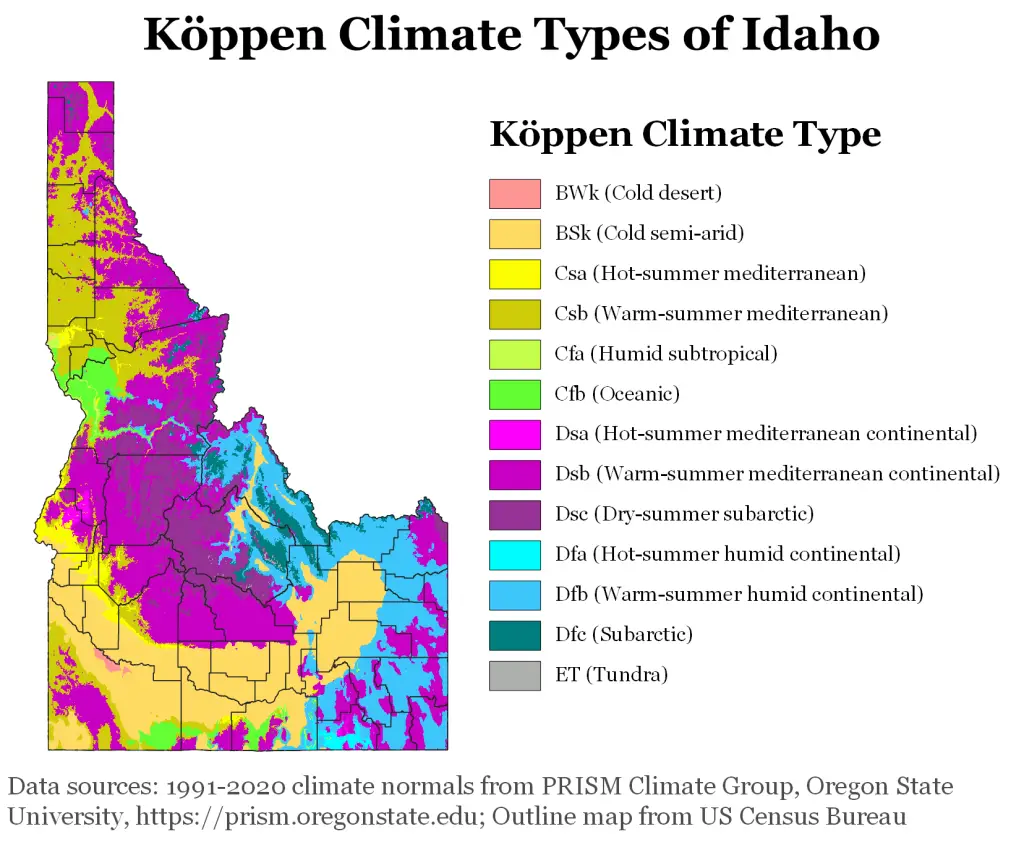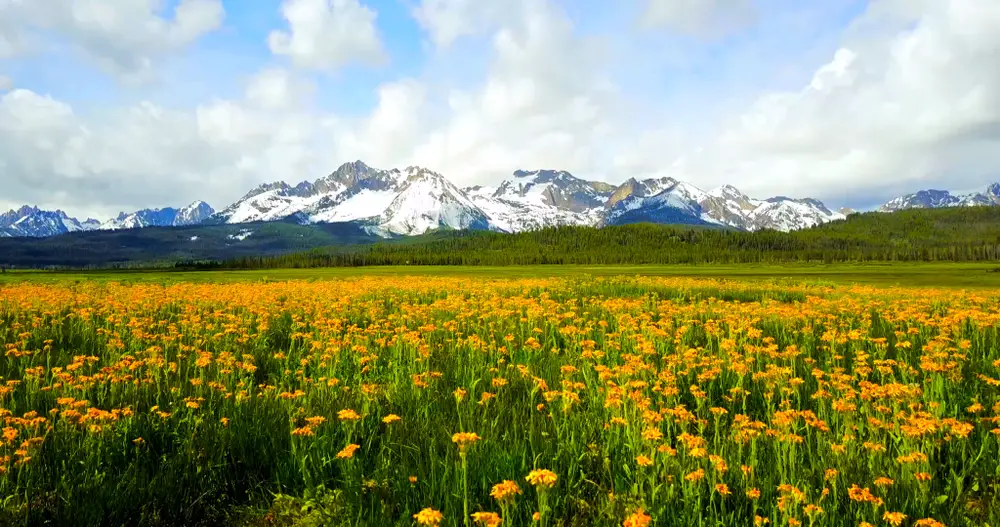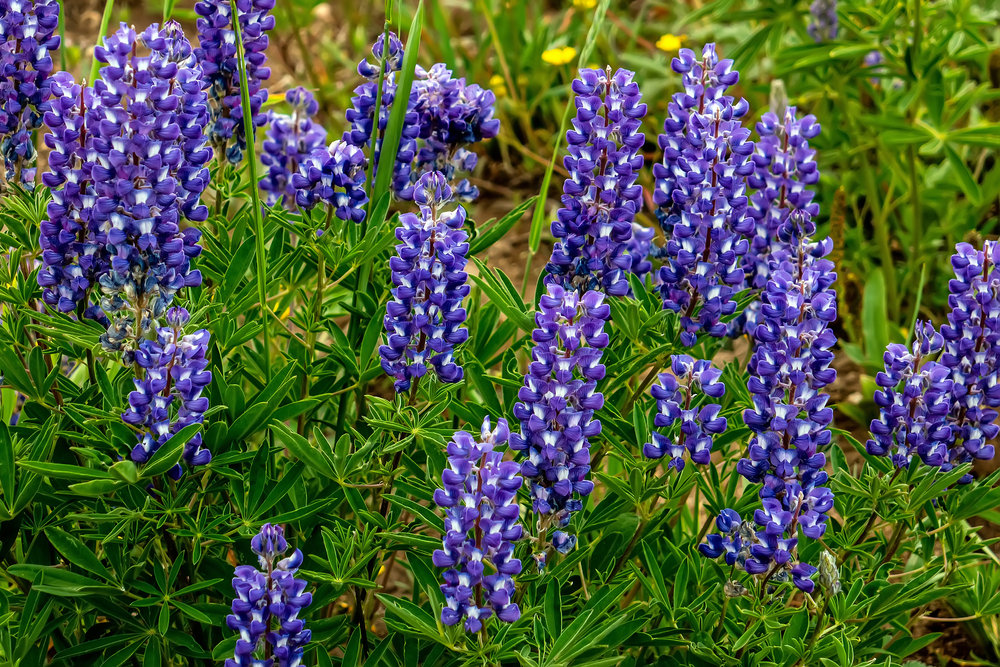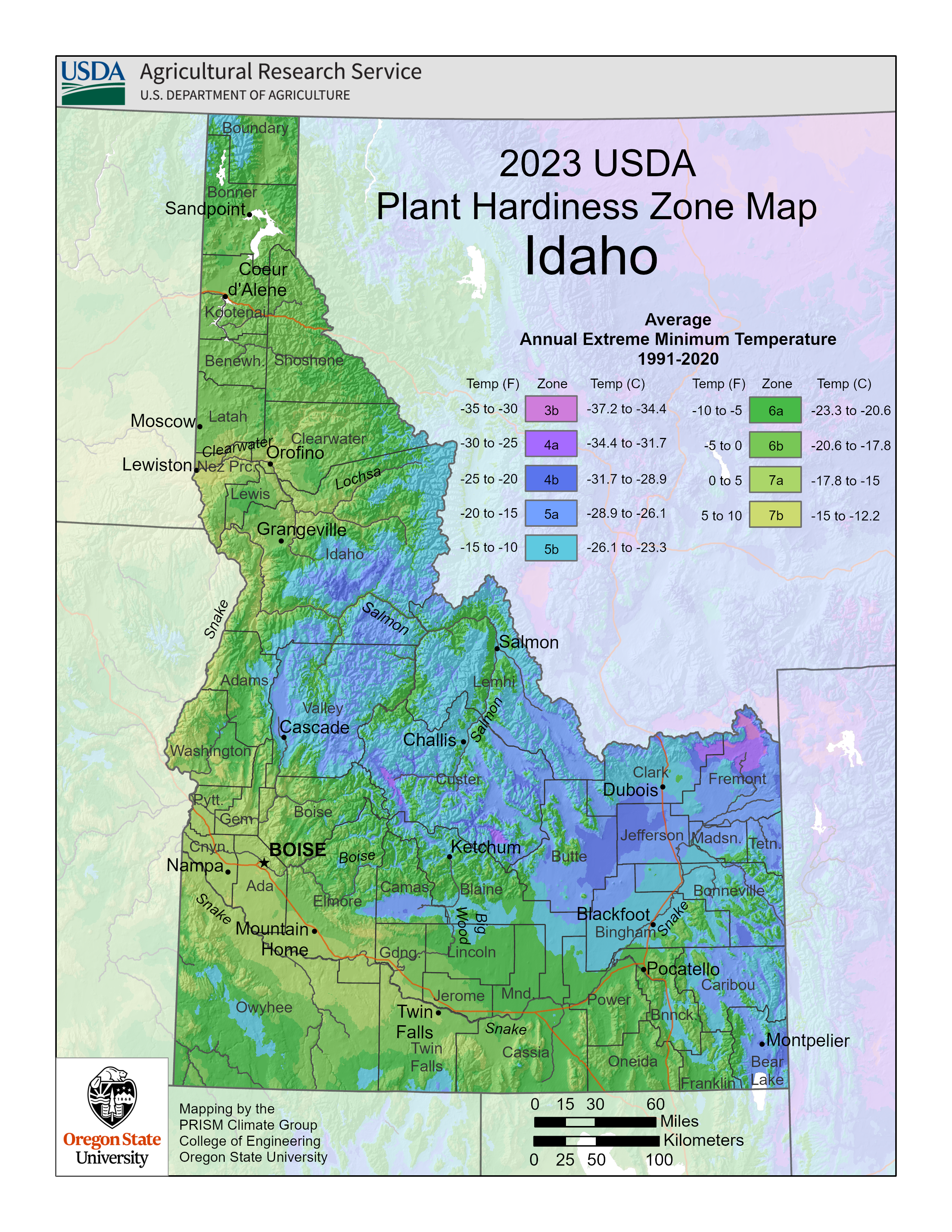Idaho Plant Hardiness Zones
| USDA Hardiness Zone | Average Minimum Extreme Winter Temperature Range Fahrenheit (°F)Celsius (°C) | Average Last Frost Date Range In Spring (Beginning Of The Growing Season) | Average First Frost Date Range In Autumn (End Of The Growing Season) |
|---|---|---|---|
| 3b | -35°F to -30°F -37.2°C to -34.4°C | Late May to early June | Early September |
| 4a | -30°F to -25°F -34.4°C to -31.7°C | Late May to early June | Early to mid-September |
| 4b | -25°F to -20°F -31.7°C to -28.9°C | Late May | Early to mid-September |
| 5a | -20°F to -15°F -28.9°C to -26.1°C | Mid to late May | Mid to late September |
| 5b | -15°F to -10°F -26.1°C to -23.3°C | Mid to late May | Mid to late September |
| 6a | -10°F to -5°F -23.3°C to -20.6°C | Mid to late May | Mid to late September |
| 6b | -5°F to 0°F -20.6°C to -17.8°C | Mid to late May | Mid to late September |
| 7a | 0°F to 5°F -17.8°C to -15°C | Early to mid-May | Late September to early October |
| 7b | 5°F to 10°F -15°C to -12.2°C | Late April to early May | Late September to early October |
Idaho Growing Conditions

Credit to Wikipedia
General Climate
Idaho has a variety of continental climates as well as semi-arid regions. Three distinct growing areas exist in Idaho:
- Northern Idaho
- Eastern and Central Idaho
- Southwestern Idaho
The mountains of the state create various climate patterns that are, generally speaking, affected by elevation. Typically, as elevation increases, temperature drops, and precipitation increases.
Northern Idaho has a continental climate and falls within the cooler temperature ranges in the state. Frost dates vary significantly based on elevation.
Southwestern Idaho is warmer and has a longer growing season. The climate is semi-arid. Though the area experiences all four seasons, it is often sunny. Mountains flank the area on all sides, so it receives less precipitation than other areas.
Eastern and Central Idaho have continental climates. This means they have warm summers and cold winters and the growing season is short, varying based on elevation. Gardening in this part of Idaho can be more challenging.
Microclimates
USDA plant hardiness zones are an important starting point for your garden, but you’ll also need to consider microclimates.
Microclimates are areas where specific conditions create a climate different from the climate they’re situated in.
Buildings, fences, paved areas, or short hills and valleys can create these microclimates.
They can be as small as a space in your backyard or as large as a city.
In other words, learn about your local conditions from local experts to see if your garden falls into a microclimate.
Extreme Weather
Blizzards
Blizzards are winter snowstorms with strong winds and intense snowfall over several hours. They limit visibility and can leave behind large amounts of snow.
These elements and the freezing temperatures present a risk of damage to your plants.
To prevent what is known as “winter kill” (exactly what it sounds like), select and plant varieties that can withstand cold temperatures.
You likely won’t have problems in your garden as a result of snow.
To prepare your plants for winter, wrap them with burlap, water deeply, and cover their roots with a layer of straw or wood chip mulch before temperatures drop below freezing. You don’t have to do all of these, but each helps in its own way.
If you have any amount of snow, pile it over top of growing beds. As it melts, your soil absorbs the moisture.
If you have one, you can also fill your rain barrel with snow and use the water from there later.
Thunderstorms
Several regions throughout Idaho experience powerful thunderstorms. These storms include strong, damaging winds, thunder, lightning, and pronounced rain that can create floods.
As such, it’s a good idea to determine the prevailing winds in your area and locate growing beds in places that afford your plants some protection or shelter. These may be next to existing structures or windbreaks.
Staking and supporting plants also help protect against wind damage to some extent. You can also attach sheets or floating row cover to stakes, trellises, and planting cages. Doing so will help provide some protection in the event of storms.
Flash Floods
Though flooding is not particularly frequent in Idaho, flash floods do sometimes occur in its mountainous regions.
Large amounts of rain cause flooding, especially as they cause watercourses such as rivers and streams to overflow.
When water has no immediate place to drain, it can create extensive damage, resulting in landslides.
Appropriately grade and slope your garden to improve drainage. This is the best course of preventative treatment to help manage this risk.
Growing Season
Idaho’s growing season is relatively short, though this can vary based on altitude. Temperatures can vary significantly between day and night throughout the state. Choose plants acclimated to these fluctuations.
Use USDA data and recommendations as starting points. Remain aware of current weather conditions. This will allow you to adapt to yearly variations appropriately.
Idaho Gardening Tips

Choose The Right Plants
In Idaho, you must contend with various conditions, such as arid conditions, sometimes poor soils, quickly changing temperatures, and a relatively short growing season. Plants raised to withstand the challenges specific to the conditions of Idaho have the best chance of surviving.
Extend Your Growing Season
Since Idaho’s growing season is on the shorter end, growing plants with lengthy growing times means starting seeds indoors and transplanting seedlings to your garden once temperatures have warmed.
To extend the season in the autumn and protect your plants from frost damage, use sheets, floating row cover, frost cloth, cloches, hoop houses, or even cold frames and greenhouses to maintain temperatures good for growing for a few days, weeks, or months more.
Practice Water-Wise Gardening
Maximize your available water resources if you’re in one of Idaho’s arid growing regions.
Install rain barrels or other water catchment systems to capture precipitation. You can also install drip irrigation systems to facilitate growth even through droughts.
Choosing to grow drought-tolerant plants is also helpful.
How and when you water your plants also affects your water efficiency. Water low to the ground, underneath plant foliage, to avoid splash up and potential transmission of disease from the soil. Watering early in the day before the heat has accumulated mitigates the evaporation risk.
Deep watering once a week is better for your plants than little bits of moisture here and there. Doing so allows water to permeate deeper and remain in the soil (and available to your plants) longer.
Practice Soil Care
Improving soil structure through the addition of organic materials such as compost, straw, grass clippings, or wood chips benefits your garden in the following ways:
- Improving soil quality as it breaks down
- Retaining water in the soil
- Suppressing weeds
- Insulating roots from extreme temperatures
- Inviting healthy garden predators to keep pest populations down
Idaho soil can be sandy. This means water and nutrients will simply pass through the soil. Adding organic material such as decomposing leaves, grass clippings, straw, or finished compost will improve the soil.
Consult With Local Professionals
Consulting with local gardening professionals allows you to benefit from their experience with your area’s conditions, the plants that do well there, and overall best practices.
Idaho Plant Suggestions

Trees
- Western White Pine (Pinus monticola)
- Bigtooth Maple (Acer grandidentatum)
- Western Larch (Larix occidentalis)
Shrubs
- Bitterbrush (Purshia tridentata)
- Wild Mock Orange (Philadelphus lewisii)
- Sagebrush (Artemesia tridentata)
Flowers
- Silvery Lupine (Lupinus argenteus)
- Common Camas (Camassia quamash)
- Arrowleaf Balsamroot (Balsamorhiza sagittata)
Vegetables
- Asparagus (Asparagus officinalis)
- Beets (Beta vulgaris)
- Potatoes (Solanum tuberosum)
Herbs
- Chives (Allium schoenoprasum)
- Thyme (Thymus vulgaris)
- Spearmint (Mentha spicata)
Spices
- Juniper Berry (Juniperus communis)
- Caraway seeds (Carum carvi)
- Catmint (Nepeta cataria)
Fruits
- Huckleberry (Vaccinium spp.)
- Elderberry (Sambucus spp.)
- Apples (Malus domestica ‘Gala’)
Succulents
- Chinese Stonecrop (Sedum tetractinum)
- Shrubby Ice Plant (Ruschia pulvinaris)
- Ruby Mantle Sedum (Sedum spurium ‘Ruby Mantle’)
Disclaimer
Any of the above can change and is not exhaustive.
Treat anything above like a good starter guide. Then use that as a foundation as you consult with local gardeners, professionals, forecasts, guides, and organizations.

